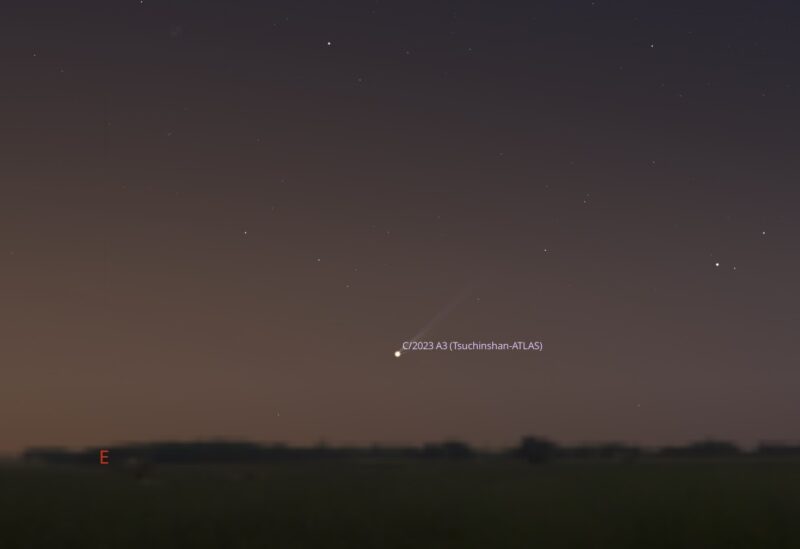
A bright comet for September and October?
The rumors of Comet A3 Tsuchinshan-ATLAS’s demise were premature. Earlier in 2024, there were reports that the comet was breaking up. But instead, the comet is now coming into morning skies and appears to be in good shape. Its current brightness would put it just within reach of the unaided eye from a dark, country site, at magnitude 5.5. With ordinary binoculars, it should be possible to pick up now. And it’s getting brighter.
Despite the previous reports that the comet might be disintegrating, the latest observations by sun-observing satellites and amateur astronomers indicate the comet is still very much alive. In fact, comet expert Terry Lovejoy was able to photograph the comet on the morning of September 11, 2024, from Queensland, Australia. He used a camera with a 135mm f1.8 lens.
Meanwhile, observer Colin Drescher was also able to capture some of the first recovery images using just a small digital telescope.
How bright will it get?
Comets are unpredictable. And there’s no way to know at this time exactly how bright Comet A3 will become. But preliminary estimates suggest it might reach magnitude 4 to 3 (the lower the number, the brighter) around the time of its closest approach to the sun – or perihelion – on September 27.
The exciting part might come afterwards. It could grow as bright as magnitude 2.5 to 2 during closest approach to Earth on October 12. Or maybe even slightly brighter if we are lucky (or fainter if we’re unlucky), since comet behavior is so difficult to predict.
So Comet A3 isn’t going to be a Comet of the Century. But if it continues to perform well, it might be the brightest comet of the year.

How to see Comet A3 in September
Observers in the Southern Hemisphere have the best seats to view the comet during the first half of September. Observers closer to Earth’s equator will get their first opportunities from mid-September to the end of the month. And for those in the lower United States, the first dawn views of Comet A3 might be possible starting around September 18 to 20. It’ll get a bit easier to locate by the end of the month.
One caveat: observers would require a clear, unobstructed view of the eastern horizon.
By the end of September, Comet A3 will gradually make the transition from the brief dawn appearance to the western skies at dusk. It may become visible starting around October 12, which is the date of closest approach to Earth. If it survives its encounter with the sun, the comet should put on a good show by mid-October.
Comet A3 in October
After the comet gets closest to the sun, it will swing around near Earth. But as it does so, it passes almost directly between Earth and the sun, making it challenging to view. In early October, the comet will be in the dawn sky in Leo and near the constellations Hydra and Crater.
Starting from October 13 to 14, Comet A3 will be easier to spot on the following evenings. That’s thanks to the comet’s great speed, which will cause it to appear higher in the western sky on the following nights.
Then in late October, as it appears on the other side of the sun, it will move into the evening sky, passing through Serpens Caput and into Ophiuchus.

Finder charts for Comet Tsuchinshan-ATLAS
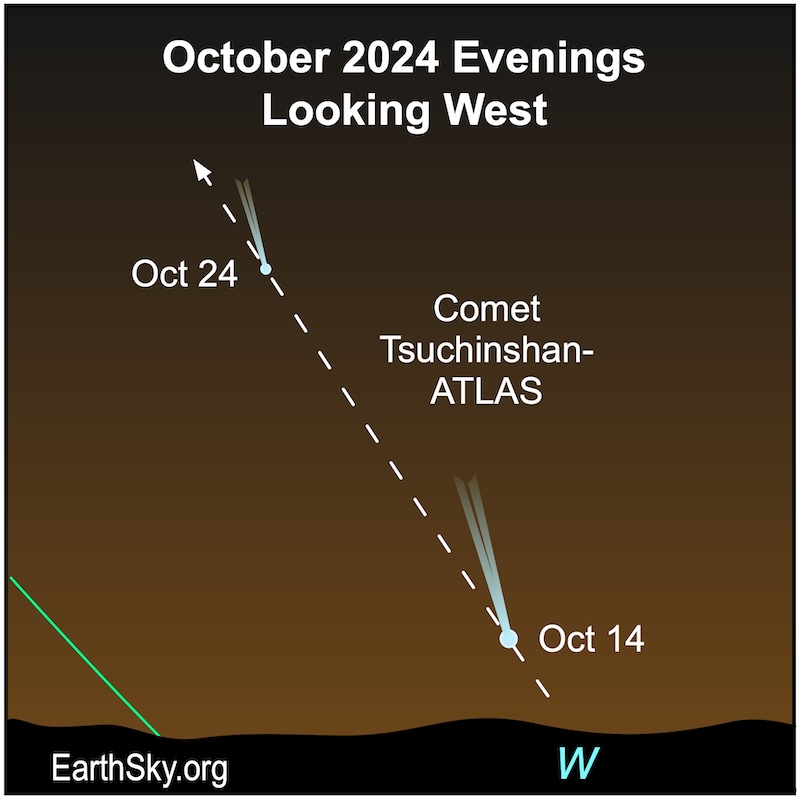
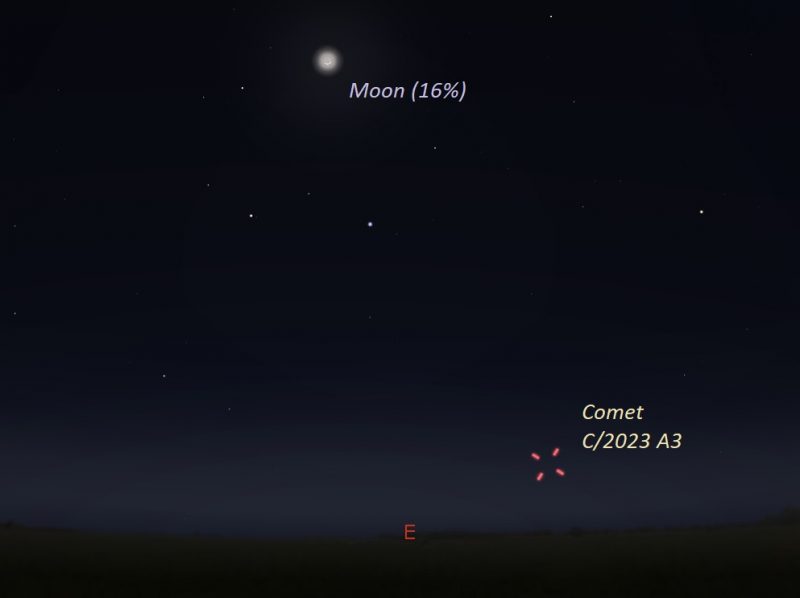
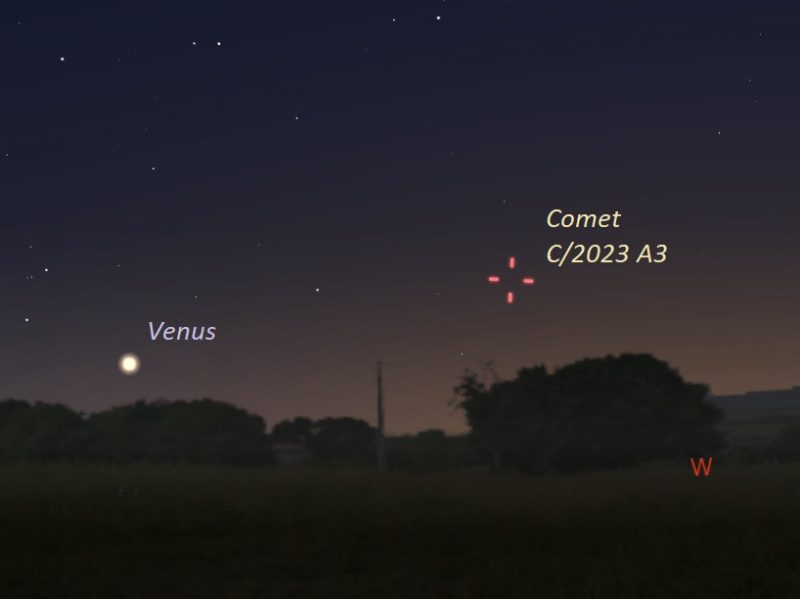

A speedy ball of ice and dust
Comet Tsuchinshan-ATLAS is blazingly speedy. It’s tearing through the inner solar system at 180,610 miles (290,664 km) per hour or 80.74 km per second, relative to Earth. And you can see its amazing speed with a small telescope. You can watch the comet’s location gradually change by comparing its exact position against background stars just 15 minutes later.
Comet A3 Tsuchinshan-ATLAS’s disintegration rumors
Comet A3 Tsuchinshan-ATLAS hasn’t been acting as people expected it to. As it was approaching the inner solar system in early 2024, it wasn’t brightening as much as expected. And then a study suggested the cometary nucleus was fragmenting.
The paper’s author, Zdenek Sekanina, a Czech-American astronomer and comet expert at NASA’s Jet Propulsion Laboratory, said on July 8, 2024, the comet entered an advanced phase of fragmentation. He said the end of Comet Tsuchinshan-ATLAS was inevitable.
However, comets are notorious for being erratic and unpredictable. And this one proved to be as well.
Discovery and naming
The Asteroid Terrestrial-impact Last Alert System (ATLAS) telescope in South Africa discovered Comet C/2023 A3 on February 22, 2023. Additionally, observers at Purple Mountain (Zijin Shin or Tsuchinshan) Observatory in China found the comet independently on images from January 9, 2023. Therefore, the comet also has the nickname Tsuchinshan-ATLAS.
At discovery, the comet was still 7.3 astronomical units (AU) from the sun, and shining at a dim magnitude 18.
Preliminary analysis of its trajectory suggests comet “A3” completes an orbit around the sun every 80,660 years.
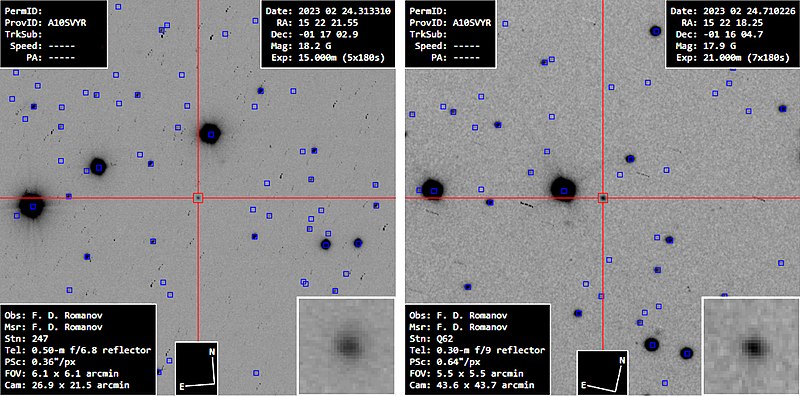
Bottom line: Comet A3 Tsuchinshan-ATLAS survived its rumored disintegration and may become the brightest comet of the year this September and October.
Source: Inevitable Endgame of Comet Tsuchinshan-ATLAS (C/2023 A3)











